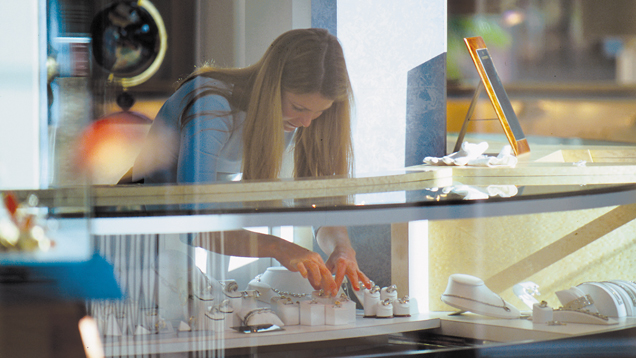Jewelry Sales Stay Flat for Season; High End Beats Trend
January 23, 2017

Overall, retail sales showed a reasonable upturn during the holiday season − but sales of jewelry failed to grow. The National Retail Federation (NRF) announced that retail sales from all channels climbed 4% from the previous year. Not surprisingly, the rise in online sales was much greater at 13%.
Retail jewelry sales, however, were “flat to modestly down” compared to last year, according to Mark Light, CEO of Signet Group, the parent company of Kay Jewelers, Zales and Jared the Galleria of Jewelry. Signet reported that its same-store seasonal sales were down 4.6%. Light said these results were “in line with the jewelry market” (as a whole). The company said its ecommerce platform was beset by technical problems resulting in a 2.6% sales decline.
Tiffany & Co., reported a 2% same-store sales decline. Its North American same-store sales fell 4%, while they were up 7% in Asia and the Far East. The company noted that protests outside the Trump Tower in New York City, which restricted access to its flagship store next door, resulted in a 14% sales decline at that location.
Michael Hill, an Australian-based retail jewelry chain with 10 stores in the U.S., reported that sales fell 5.6% during the holiday period.
The one bright spot was the higher-end independents. Some 63% of respondents to the Centurion Holiday Sales Success Index reported that this year’s holiday season was much stronger than last year − and 68% of respondents reported that their total year sales were up as well.
The survey broke down the responses:
- 32.5% said holiday season sales grew substantially − more than 10% over last year’s figures
- 12.5% reported sales gains of 6% to 10%
- 17.5% reported modest holiday gains of 1% to 5%
There were some negatives in the Centurion poll: 20% of respondents saw sales fall off more than 10%, while 15% reported that sales were down anywhere from 1% to 10% from last year’s figures.
In general, various surveys showed that brick and mortar store sales fell between 7% and 10%, while online gained. This was in line with the NRF report, which showed that department stores sales eroded an average of 7% this season.
Department stores are facing deeper issues than declining middle class purchasing power. Most department stores anchor shopping malls. However, an estimated 15% of U.S. malls will fail or be changed into non-retail space within the next 10 years, according to a report by Green Street Advisors, a real estate analytics firm.
Despite a trend toward online sales, Blue Nile was registering weak numbers through the year before announcing its sale to an investment group in the fall. The company typically reports its holiday sales in early March.
De Beers’ CEO Bruce Cleaver, in an interview with the Associated Press, said that demand was running toward smaller diamond pieces because millennials are less affluent than previous generations were at the same age. He did say, however, that the percentage of self-purchased diamond jewelry is on the rise.
Cleaver reported that a De Beers analysis found that the U.S. comprises 45% of global diamond jewelry demand. It also showed that China, including Hong Kong, is about 16%, India is about 8% and Japan is about 5%.
In a New Year address to clients, Cleaver said De Beers remained committed to maintaining marketing efforts for diamond and jewelry, and to technological developments to identify synthetic diamonds entering the market.
While the latest numbers from China’s largest retail jewelry chain, Chow Tai Fook, sound encouraging − a 4% same-store sales increase on the mainland − they don’t help the diamond trade that much. All of the sales increases came from gold jewelry, while “gem set” jewelry continued its two-year slide, down 4% on the mainland and 17% in Hong Kong.
MINING
Alrosa reported a 26% increase in rough sales to $4.49 billion for 2016. The results reflect a recovery in the rough market from the chaos of 2015, when clients refused to take goods from major suppliers because prices had climbed well above the cost of the resulting polished. Alrosa cut rough prices an average of 15% during the year.
Alrosa plans to increase production 5% across the board this year by expanding operations of its Internatsionalny mine and its new Zarya pipe, a relatively low yielding resource. Both are in the western part of the Russian republic of Yakutia. The company also plans to step up its marketing in Asia through its new sales facility in Vladivostok. Alrosa produced an estimated 38 million carats in 2016.
De Beers will likely post strong sales gains (+35%) for the year for the same reason: clients bought very few goods in the final quarter of 2015. De Beers trimmed prices as well.
The new reality − that diamond demand and prices will not rise exponentially over the long term, as predicted during the previous decade − has hit diamond mining companies' projects that were on tap for development based on such predictions.
De Beers will soon flood the Snap Lake mine in Canada. The company spent $1 billion developing it, but the mine never turned a profit because demand and prices remained well below expectations. Rio Tinto also walked away from the Bunder project in India last year.
Russell Shor is senior industry analyst at GIA in Carlsbad.



